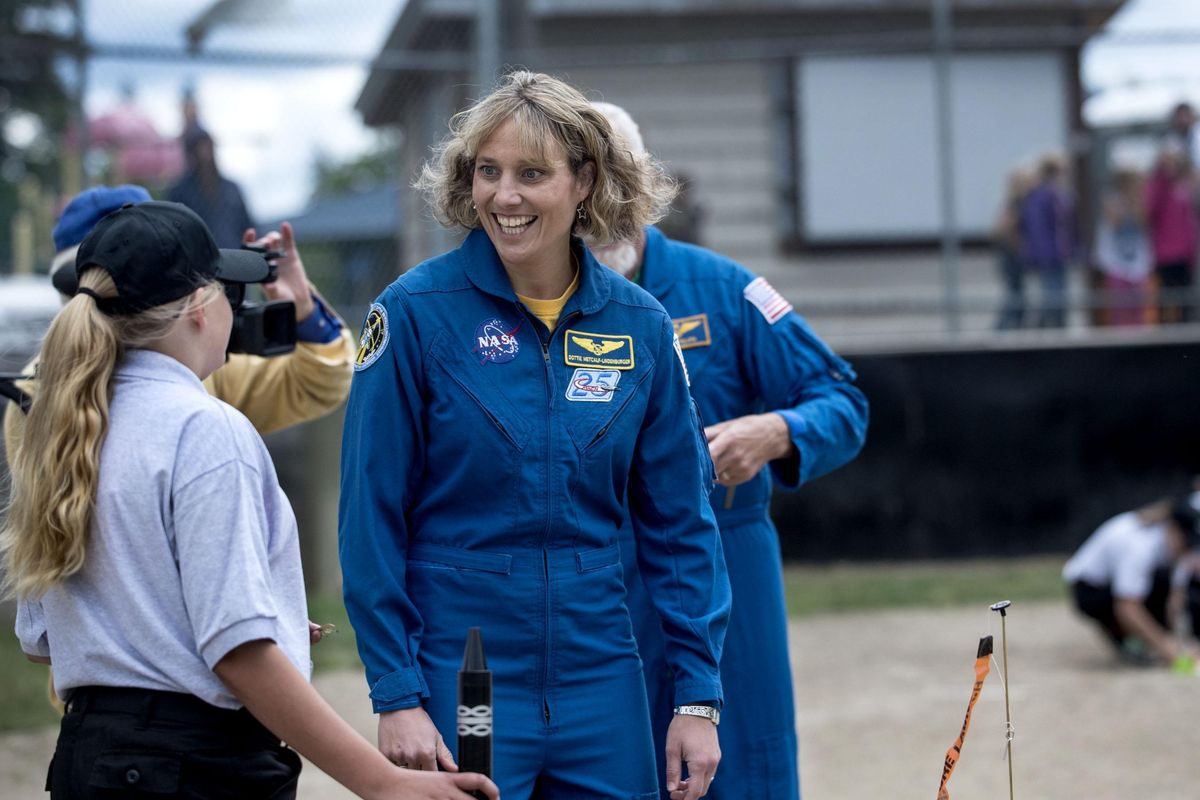Priest River teacher marks 25 years of astronaut visits

PRIEST RIVER – Someone once told teacher Chris Naccarato he’d never get an astronaut to visit his students at Priest River Elementary School.
He didn’t get one. He got more than 20 astronauts – and one cosmonaut – to travel to the small town west of Sandpoint in his 25 years of teaching there. Scott Carpenter, Richard Gordon, Jerry Ross and moonwalker Charlie Duke are among the NASA veterans who accepted his invitation.
“It’s been an amazing adventure, you know. It’s been incredible,” said Naccarato, whose lifelong zeal for space exploration is infectious. “To think all that has happened right here in Priest River, Idaho.”
The latest guests of honor were at the school Thursday for what has become an annual highlight – capped by model rocket launches over the ball field – for Naccarato’s fifth-grade class and the entire school.
Dorothy Metcalf-Lindenburger, a Seattle teacher who flew to the International Space Station as a mission specialist in 2010, was there. So was David Marquart, a retired Boise teacher who was one of 10 educators NASA named as finalists for the 1986 Challenger shuttle launch that ended in catastrophe. And making his ninth appearance was Sandpoint resident John Phillips, who logged 203 days in space in three flights.
Each year Naccarato uses a Mission Control theme to teach his students about teamwork, responsibility and interpersonal skills. The 25 kids in his NACA program – the National Astronauts in the Classroom Association – take it seriously. Dressed in matching black cargo pants, gray polo shirts and black caps, they marched into the classroom with military precision, sat still on the floor and asked the guest speakers questions they scrawled on index cards.
Did you ever chew bubble gum in space? Do you read books in space? Can you get good Internet up there?
One student asked about their least favorite part of the space program. “Sitting in meetings,” Metcalf-Lindenburger replied.
She also advised the class, “It’s going to be very important for you to remain curious for the rest of your life. Curiosity is probably what got all of us the jobs that we have.”
Naccarato reminisced about the years of astronaut visits and what inspired his love of the subject. His passion is evident on every wall of the classroom, a shrine to the cosmos and manned spaceflight, plastered with planet posters, star charts and signed portraits of John Glenn, Chuck Yeager and other heroes of his.
He showed photos of his childhood space toys and said he probably drank more Tang than any other kid.
Naccarato originally booked former astronaut Barbara Morgan, a teacher in McCall, Idaho, to visit this year, but she wasn’t able to make it. But Morgan sent a couple of signed portraits as well as a packet of cinnamon basil seeds that had flown in space – a horticulture project for the students to take on.
Previous NACA students have their names on a Mars rover, and the program logo appears on a probe deep in the solar system’s asteroid belt and also has flown on the International Space Station.
One year the students exchanged emails with astronaut Steve Swanson during his six-month space mission, and Swanson sent back a captivating photo he made of the northern Panhandle’s lakes and mountains.
“It’s an honor and a privilege to work with kids like this all year,” Naccarato said Thursday.
The group then went outside, where the students embraced roles they rehearsed for months, dashing across the baseball diamond to prepare several rocket launches from the pitcher’s mound. Their teacher ran through a series of checks over walkie-talkies, and each team responded, “Go flight!”
Metcalf-Lindenburger, Marquart and Phillips took turns launching the rockets, and students from other classes cheered the whoosh of the rockets and the parachute glides back to ground.
Addisen Kingery, 11, served as an Electrical Generation and Illumination officer for the launches.
“It’s super fun, and I’m glad we got to do this, because we worked super hard,” Kingery said.
She added that Naccarato teaches them other subjects as well. “People think he’s all about space, but he’s not.”
Except on this day.
To mark the 25th year of his program, Naccarato chose the words of the late Alan Shepard Jr., the first American to travel into space, from when the astronaut landed on the moon in 1971:
“It’s been a long way, but we’re here.”